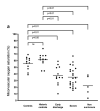COVID-19 Patients Have Peripheral Microvascular Dysfunction and Tissue Hypoxia in Spite of Successful Treatment of Lung Failure: A Proof of Concept Study
Knut Kvernebo; L. Liv Kristin Wikslund; Kamila Drezek; Andrea Jaramillo; Luigino Capone; Maged Helmy; Yunong Zhao; Aaron Aguirre; David D'Alessandro
BACKGROUND
Availability of oxygen (O2) is essential for life and function of all cells of the human body (n ≈ 1013–1014 cells). COVID-19 patients often have impaired lung function with compromised oxygen uptake, but little is known about microvascular oxygen delivery and tissue oxygenation.
OBJECTIVES
Use the Oxygen Delivery Index (ODIN) concept to assess peripheral microvascular regulation and oxygen extraction in COVID-19 patients.
METHODS
The ODIN concept includes two technologies (diffuse reflectance spectroscopy—DRS and computer assisted microscopy—CAM) for data acquisition from subepidermal nutritive capillaries. Output parameters are microvascular oxygen saturation (SmvO2) and functional capillary density (FCD).
RESULTS
Forty patients hospitalized for COVID-19 grouped into early discharge (< 7 days, n = 11), severe (beyond 7 days, n = 24) and non-survivors (n = 5), and healthy controls (n = 23) were examined.
Microvascular oxygen saturation (SmvO2) and the corresponding O2 extraction (SaO2—SmvO2) was 56% ± 4%/42% ± 9% (mean ± SD) in healthy controls (n = 11), 61 ± 10/37 ± 10 for historic controls (n = 12), significantly different (p < 0.01) as compared with all COVID-19 groups (early discharge: 40% ± 13%/54% ± 13%, severe: 34% ± 15%/60% ± 15%, non-survivors 22% ± 15%/73% ± 16%). FCD expressed as the relative number of red pixels (belonging to a capillary erythrocyte) in a CAM frame were reduced in alle patient groups as compared to historic controls (p < 0.05).
CONCLUSION
Results show skin microvascular dysregulation and tissue hypoxia in patients, indicative of hypoxia also in other tissues. We hypothesize that tissue hypoxia is a cause of reversible and non-reversible long COVID-19 symptoms and of mortality.
Link | PDF | Microcirculation [Paywall]
Knut Kvernebo; L. Liv Kristin Wikslund; Kamila Drezek; Andrea Jaramillo; Luigino Capone; Maged Helmy; Yunong Zhao; Aaron Aguirre; David D'Alessandro
BACKGROUND
Availability of oxygen (O2) is essential for life and function of all cells of the human body (n ≈ 1013–1014 cells). COVID-19 patients often have impaired lung function with compromised oxygen uptake, but little is known about microvascular oxygen delivery and tissue oxygenation.
OBJECTIVES
Use the Oxygen Delivery Index (ODIN) concept to assess peripheral microvascular regulation and oxygen extraction in COVID-19 patients.
METHODS
The ODIN concept includes two technologies (diffuse reflectance spectroscopy—DRS and computer assisted microscopy—CAM) for data acquisition from subepidermal nutritive capillaries. Output parameters are microvascular oxygen saturation (SmvO2) and functional capillary density (FCD).
RESULTS
Forty patients hospitalized for COVID-19 grouped into early discharge (< 7 days, n = 11), severe (beyond 7 days, n = 24) and non-survivors (n = 5), and healthy controls (n = 23) were examined.
Microvascular oxygen saturation (SmvO2) and the corresponding O2 extraction (SaO2—SmvO2) was 56% ± 4%/42% ± 9% (mean ± SD) in healthy controls (n = 11), 61 ± 10/37 ± 10 for historic controls (n = 12), significantly different (p < 0.01) as compared with all COVID-19 groups (early discharge: 40% ± 13%/54% ± 13%, severe: 34% ± 15%/60% ± 15%, non-survivors 22% ± 15%/73% ± 16%). FCD expressed as the relative number of red pixels (belonging to a capillary erythrocyte) in a CAM frame were reduced in alle patient groups as compared to historic controls (p < 0.05).
CONCLUSION
Results show skin microvascular dysregulation and tissue hypoxia in patients, indicative of hypoxia also in other tissues. We hypothesize that tissue hypoxia is a cause of reversible and non-reversible long COVID-19 symptoms and of mortality.
Link | PDF | Microcirculation [Paywall]


